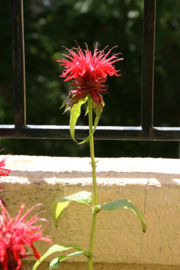Monarda didyma: Difference between revisions
No edit summary |
No edit summary |
||
| Line 1: | Line 1: | ||
{{SPlantbox | {{SPlantbox | ||
|familia=Lamiaceae | |||
|genus=Monarda | |genus=Monarda | ||
|species=didyma | |species=didyma | ||
|common_name=bee balm, oswego tea, horsemint | |||
|habit=herbaceous | |||
|Min ht metric=cm | |Min ht metric=cm | ||
|Max ht box=1 | |||
|Max ht metric=m | |||
|Max wd box=20 | |||
|Max wd metric=cm | |||
|lifespan=perennial | |||
|exposure=sun | |||
|water=moderate | |||
|features=fragrance, edible | |||
|Temp Metric=°F | |Temp Metric=°F | ||
| | |sunset_zones=2-11, 14-17, 30-41 | ||
|image= | |image=Monarda-didyma.JPG | ||
|image_width= | |image_width=180 | ||
}} | }} | ||
This plant provides flavor and scent with its leaves and flowers. The Earl Grey tea is scented with this plant. | |||
{{Inc| | {{Inc| | ||
Monarda didyma Linn (M. Kalmiana, Pursh. M. coccinea, Hort.). Oswego Tea. Bee-balm. Fragrant Balm | Monarda didyma Linn (M. Kalmiana, Pursh. M. coccinea, Hort.). Oswego Tea. Bee-balm. Fragrant Balm. St. acutely 4-angled: lvs. thin, ovate- lanceolate, acuminate. Vars. alba and rosea, Hort., are offered, but the latter should be compared with the next species. In 1893 John Saul advertised M. Kalmiana as if horticulturally distinct, calling it the finest of monardas. Var. salmonea, Perry. Large heads of delicate shade of salmon-pink.—Suited to moister positions than the others. | ||
}} | }} | ||
==Cultivation== | ==Cultivation== | ||
{{edit-cult}}<!--- Type cultivation info below this line, then delete this entire line --> | {{edit-cult}}<!--- Type cultivation info below this line, then delete this entire line --> | ||
| Line 93: | Line 59: | ||
{{stub}} | {{stub}} | ||
__NOTOC__ | |||
Latest revision as of 21:38, 7 January 2010
| Monarda didyma subsp. var. | bee balm, oswego tea, horsemint | |||||||||||||||||||||||||||||||||||||||||||||||||||||||
|---|---|---|---|---|---|---|---|---|---|---|---|---|---|---|---|---|---|---|---|---|---|---|---|---|---|---|---|---|---|---|---|---|---|---|---|---|---|---|---|---|---|---|---|---|---|---|---|---|---|---|---|---|---|---|---|---|

|
|
| ||||||||||||||||||||||||||||||||||||||||||||||||||||||
| ||||||||||||||||||||||||||||||||||||||||||||||||||||||||
This plant provides flavor and scent with its leaves and flowers. The Earl Grey tea is scented with this plant.
| Standard Cyclopedia of Horticulture |
|---|
|
Monarda didyma Linn (M. Kalmiana, Pursh. M. coccinea, Hort.). Oswego Tea. Bee-balm. Fragrant Balm. St. acutely 4-angled: lvs. thin, ovate- lanceolate, acuminate. Vars. alba and rosea, Hort., are offered, but the latter should be compared with the next species. In 1893 John Saul advertised M. Kalmiana as if horticulturally distinct, calling it the finest of monardas. Var. salmonea, Perry. Large heads of delicate shade of salmon-pink.—Suited to moister positions than the others.
|
Cultivation
- Do you have cultivation info on this plant? Edit this section!
Propagation
- Do you have propagation info on this plant? Edit this section!
Pests and diseases
Very sensitive to mold. Do not overwater.
Cultivars
Scarlet colored: 'Adam' Pink colored: 'Croftway Pink', 'Granite Pink', 'Marshall's Delight', 'Snow White' Dark red colored: 'Mahogany', 'Cambridge Scarlet' 'Violet Queen'
Gallery
If you have a photo of this plant, please upload it! Plus, there may be other photos available for you to add.
-
photo 1
-
photo 2
-
photo 3
-
Monarda didyma
References
External links
- w:Monarda didyma. Some of the material on this page may be from Wikipedia, under the Creative Commons license.
- Monarda didyma QR Code (Size 50, 100, 200, 500)

